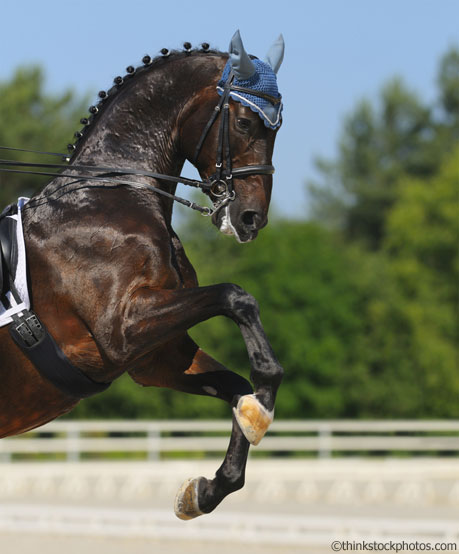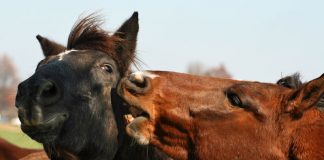
It’s not unusual to see a horse rear. A frisky horse cavorting with a pasture mate may stand on its hind legs as a playful expression. Rearing is also a defensive posture that feral horses use to fend off predators. But when rearing occurs under saddle it’s because the horse has absolutely refused to go forward. Once learned, this behavior can become a dangerous vice. Here’s how to ride through a rear and tips on how to prevent it from happening again.
- The moment your horse begins to rear, loosen the reins by pushing your hands toward your horse’s mouth. Resist the urge to pull back on the reins. That won’t stop the rear and it could flip the horse over.
- Remain centered in the saddle. Don’t lean off to one side or you could tumble off over your horse’s shoulder. Do, however, tip your upper body slightly forward, into your horse’s neck. This will help your body stay in synch with the motion of your horse.
- If you need some extra security, grab hold of the mane, saddle horn or pommel.
- Once your horse places his front feet on the ground, urge him forward by squeezing with your legs.
- If your horse balks and threatens to rear again, use one rein, held out to the side, to lead him into a turn or half-circle. Then, if he does attempt to rear again, it’ll be less powerful; most of his energy will be directed laterally rather than upward.
- Once you’ve defused the situation, investigate why your horse reared. Are you using a bit that’s too severe? A harsh bit bumping a tender mouth can incite a rear. Could your hands be the culprit? If you’re kicking the horse forward with your heels, yet also hanging onto the reins for support, then your horse could rear out of frustration.
- Despite what may pass for sage advice, never punish your horse for rearing by hitting him between the ears (on the poll) or intentionally pulling him to the ground. Not only could this end in tragedy, but it doesn’t address why the horse reared in the first place.
Further Reading
See more Horsemanship How-tos >>






Rearing may look pretty but is a very dangerous habit.
I hope it never happens to me, but now I would have an idea what to do, if I can remember at the time.
Years ago, one of my horses reared on me. I leaned forward and managed to smash my face into her upcoming head. Very painful, but it seemed to have startled her and she never reared again. I have another horse that likes to do “pop ups” – (feels like the start of a rear) so I carried an empty paper towel roll in my hand for a bit and popped him between the ears everytime he attempted to go up. He didn’t like the sound and it didn’t hurt him and he quit his little trick.
i dont think startling a horse is a good way to train.
Be sure to see your equine dentist annually for sharp points. It would have saved me six months of painful recovery when I purchased a new horse that came over backwards on top of me due to pain caused by the bit. Fortunately I’m okay although I’ll always have an indentation in my thigh where the muscle was affected.
Great article, it’s very important to know how to ride out a rear.
I would want to check for back problems, pinching tack, ill-fitting saddle, and other pain-related reasons for rearing. Teeth are also a place to check. I wouldn’t just assume that the horse is acting up–check for physical or training issues. When it comes to breaking bottles over a horse’s head–just give the poor horse a break. Try to solve it from the ground. Remember: it’s never the horse’s fault.
I went through this many times with my mare. She only dumped me once when she learned to add a little twist at the end. Now I know that as soon as she starts to even think about not going forward I put her in a tight circle to take away her shoulder. She has finally stopped rearing but I’m always watchful to make sure it doesn’t start again.
My young POA mare started rearing a few years back. I stopped riding her out of fear for our safety. I had ruled out all causes for it. It wasn’t her teeth, the bit, saddle fit, my riding, or anything else. Then, I realized she was bored. I took her out to the arena and went on an involved trail ride with another horse. When she actually had scenery to look at and had to think about where to go and dodge trees and climb hills, she went from grumpy and rearing to happy and eager. If all else fails, give your horse a different job.
The key of helping a horse through his or her rearing habit, is to use your brain! some times the weirdest things causes these habits.But never ever hurt or punish a horse for doing what there instinct tells them to do! to many times at shows i see people hurting there horses! thats bad horsemanship!! that is only going to make it worse! Also try to be understanding! horses will love it! Think like a trainer and use nice training options! Not whiping a horse between the ears to make him fear rearing! Be understanding and help your horse! Nicely! please.
I didnt see anybody even suggesting “whipping” a horse on top of the head or breaking bottles on their heads to stop them from rearing. A paper towel tube is thin cardboard. I have bopped my kids with a paper towel tube. It makes a noise is all. I rode an Appaloosa named Hotshot who had been taught to rear under saddle like the lone Ranger’s Silver. When he was sold and wound up as rental horse, he did it to intimidate riders. He tried with me-once. I smacked him good on his neck and said NO in a loud deep voice and turned him in a circle. he never did it again.
Hillary I like your thinking.
excellent Article. no nonsense, just great information
While I agree with the bulk of this article, I disagree with the advice not to lean to the side. If you stay exactly centered, you risk getting hit in the face with the horse’s head or neck when he comes up. This can easily knock you out or stun you long enough that you can’t get off him if he flips over. While you should not lean way over, you should move your head and shoulder slightly to the side. I also would advise against holding on. It’s better to be thrown clear if you can’t stay with the horse than to be clinging to him if he should go over backwards. Falling off is painful, but falling and having a horse land on you is much, much more dangerous.
I respectfully disagree with the “tip your upper body slightly forward, into your horse’s neck. This will help your body stay in sync with the motion of your horse”statement. If a horse, young or old, is of a mind to stand on his hind legs the most critical thing to do is to go as far forward as possible even putting your arms around his neck even if your body is slightly to one side. Otherwise your weight and the bulk of your body is still tipping back with him. A good position is standing in your stirrups with straight knees and kissing his ears. Also when he comes down and begins again, the one rein pull around (stop) can tip him over onto his opposite shoulder and your leg with considerable pressure. There is little you can do to correct a horse’ habit of rearing without riding it through and letting him know he accomplishes nothing.
Had a young stallion rear and flip over on me. I was lucky and came out of the saddle. He came down across my knees and tore my mcl. It could have been much worse.
I stopped my horse from doing it, by keeping a tie down on him. If he can’t lift his head he can not rear.
We had a Peruvian that didn’t want to go forward or leave the property out of his site or ride alone. Also a cross Arabian same thing didn’t want to go forward. Sometimes a crop between the ears does work when it’s a discipline problem.
I have had this situation with different horses. When the horse is down on the groud I make him rear , and rear , rear until I feel he his tired and He ask to go forward, they never make me rear again …. forward is better, rear only when I ASK to.
Tie downs do not help a rearing problem in my own personal experience. It may slow it down but it will not stop it from happening.
This article is a good article and give good advice especially at the very end about smacking a horse between the ears.
Teaching the horse that moving forward is the only only good answer for him. You may have to establish from the ground at first.
Learning to ride with one rein.
Learn a one rein stop.
Learn to move him in a circle, a small circle.
Teaching the horse to disengage his hind quarters.
Use a bit that has lateral action and no shanks.
Keeping your hands light.
You may need some spurs that roll.
You may think of using a running martingale or a training fork rather than a tie down.
Get his feet moving, they don’t rear if they are moving. However, they rear as soon as they STOP.
Good luck.
I know all too well the bad results of being on a rearing horse. When I was 18, I was riding a friend’s horse & he reared with me. At the time I knew a whole lot less about horses than I do now. I don’t know if he lost his balance or I pulled him over, but he ended up falling on me. Thank goodness he wasn’t a big horse as I ended up with a broken pelvis & a 6 week stay in the hospital. I am now 66, still ride and don’t have any problems from my accident. However, if one gets a little light on the front end now, I immediately dismount.